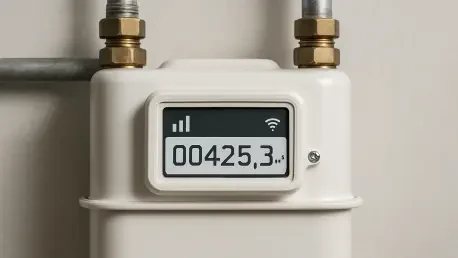In an era where energy efficiency and sustainability are paramount, the global smart gas meter market is experiencing a transformative surge, projected to grow from $2.49 billion in 2024 to an impressive $4.04 billion by 2030, reflecting a compound annual growth rate (CAGR) of 8.5%. These cutting-edge digital devices are redefining gas consumption management by providing real-time data that enhances operational efficiency and supports environmentally conscious practices. As energy grids across the world undergo modernization, smart gas meters have emerged as indispensable tools for both utilities and consumers, facilitating a shift toward smarter, more responsive energy systems. This remarkable growth is driven by a confluence of technological innovation, government backing, and a global commitment to optimizing resource use. The integration of advanced technologies such as Artificial Intelligence (AI) and the Internet of Things (IoT) further amplifies their potential, paving the way for a more connected and sustainable energy landscape.
Market Drivers and Opportunities
Technological Innovations Fueling Growth
The digital transformation of energy infrastructure stands as a cornerstone of growth in the smart gas meter market, with these devices enabling seamless two-way communication between utilities and end-users. This connectivity ensures precise data collection on gas usage, which not only improves grid reliability but also helps reduce energy waste. Beyond basic functionality, the incorporation of IoT allows for the management of an ever-increasing number of connected devices, creating a robust network for monitoring and control. Additionally, AI-driven predictive analytics are becoming instrumental in automating decision-making processes, offering utilities the ability to anticipate demand fluctuations and optimize resource allocation. These technological advancements are critical for scaling deployments, ensuring that smart gas meters can meet the complex demands of modern energy systems while supporting long-term sustainability goals across diverse regions.
Another key aspect of technological progress lies in the distinction between Automated Meter Reading (AMR) and Advanced Metering Infrastructure (AMI), each serving unique needs within the market. AMR systems provide a cost-effective solution by automating data collection without the need for manual intervention, making them ideal for regions prioritizing affordability. In contrast, AMI represents a more sophisticated approach, offering real-time data transmission and full integration with broader smart grid frameworks. This capability positions AMI as the future of energy networks, particularly in areas with advanced infrastructure. The ongoing evolution of these technologies, supported by continuous innovation in hardware and software, underscores their role as pivotal drivers, ensuring that the market remains adaptable to emerging challenges and consumer expectations through the forecast period to 2030.
Smart Grid Investments and Policy Support
Government initiatives and substantial investments in smart grid technologies are creating a fertile environment for the expansion of the smart gas meter market, with policies designed to modernize energy infrastructure taking center stage. For instance, the US Department of Energy’s allocation of $2 million for advanced metering projects exemplifies the kind of financial and regulatory support propelling adoption. Such backing not only accelerates the deployment of smart meters but also signals a broader commitment to enhancing energy efficiency on a global scale. This policy-driven momentum is evident in regions like Europe and Asia Pacific, where large-scale rollouts are transforming residential, commercial, and industrial sectors, aligning with international goals for reduced carbon footprints and optimized resource management.
Beyond current investments, the market is poised to benefit from emerging opportunities in continued smart grid initiatives and the integration of AI for enhanced functionality. These prospects offer pathways to address existing challenges, such as the complexity of integrating diverse systems into cohesive networks. AI, for instance, can improve meter accuracy and enable automated responses to consumption patterns, thereby increasing consumer trust and operational efficiency. Meanwhile, sustained focus on smart grid development ensures that infrastructure keeps pace with technological advancements, providing a stable foundation for growth. Despite hurdles like high initial costs, the alignment of policy support and innovation points to a promising trajectory, with stakeholders across the value chain working collaboratively to build resilient energy systems for the future.
Challenges and Restraints
Barriers to Adoption
Despite the promising outlook for smart gas meters, significant barriers to widespread adoption persist, with high upfront costs topping the list of concerns for many utilities and consumers. Installing these advanced systems often requires substantial capital investment, which can deter smaller markets or regions with constrained budgets from embracing the technology. Additionally, apprehensions surrounding data privacy have emerged as a critical issue, as the real-time transmission of consumption data raises questions about security and unauthorized access. These concerns are compounded by consumer worries over potential health impacts associated with the electromagnetic fields emitted by smart meter technologies, further slowing acceptance in certain demographics and areas, and tempering the overall pace of market expansion.
Another dimension of resistance stems from a lack of awareness or understanding among end-users about the benefits of smart gas meters, which can hinder adoption rates even in regions with supportive policies. Many consumers remain skeptical about transitioning from traditional metering systems, often due to misconceptions or insufficient education on how these devices can lower costs and improve energy management. This hesitation is particularly pronounced in less developed markets where infrastructure upgrades are not yet a priority. Addressing these barriers will require targeted outreach and transparent communication from utilities and policymakers to build confidence. Overcoming these financial, privacy, and perceptual obstacles is essential to unlocking the full potential of smart gas meters and ensuring equitable access to their advantages across diverse global markets.
Integration and Security Issues
The technical complexity of integrating a wide array of devices into unified smart gas meter systems presents a formidable challenge, as disparate technologies and standards can disrupt seamless operation. Utilities often face difficulties in ensuring compatibility between new smart meters and existing infrastructure, which can lead to inefficiencies or delays in deployment. This issue is particularly acute in regions with aging energy grids that were not originally designed to support digital solutions. The resulting integration hurdles not only increase operational costs but also risk undermining the reliability of data collection, a core benefit of smart metering. Tackling these technical challenges demands innovative approaches to system design and robust collaboration among industry stakeholders to establish standardized protocols.
Equally pressing is the need to prioritize data security within these interconnected systems, as the risk of cyber threats grows alongside the adoption of smart technologies. Protecting sensitive consumption data from breaches is paramount to maintaining consumer trust and ensuring regulatory compliance. Vulnerabilities in communication networks or hardware components can expose systems to potential hacks, which could have far-reaching consequences for both utilities and users. Strengthening cybersecurity measures through encryption, regular updates, and rigorous testing is critical to mitigating these risks. As the market evolves, addressing both integration complexities and security concerns will be vital to sustaining growth and fostering a reliable, trustworthy environment for smart gas meter deployment worldwide.
Regional Dynamics and Trends
Asia Pacific Leading the Charge
Asia Pacific has emerged as the frontrunner in the smart gas meter market, driven by aggressive investments and ambitious energy reforms, particularly in China, which is setting a global benchmark for innovation. The region’s rapid growth is fueled by a strong emphasis on energy efficiency and the integration of renewable sources into existing grids, necessitating advanced metering solutions to manage complex consumption patterns. China’s leadership in smart grid technologies, supported by substantial government funding, has catalyzed large-scale deployments across residential and industrial sectors. This momentum positions Asia Pacific as a critical driver of global market expansion, with its proactive approach to modernizing energy infrastructure serving as a model for other regions aiming to balance growth with sustainability.
Furthermore, the region’s diverse economic landscape, encompassing both rapidly developing nations and established markets, contributes to a dynamic adoption pattern for smart gas meters. Countries like India and South Korea are increasingly investing in smart grid initiatives to address rising energy demands and urban expansion, complementing China’s dominance. This widespread focus on technological upgrades is bolstered by regional policies that incentivize energy conservation and digitalization. As a result, Asia Pacific not only leads in terms of market size but also in pioneering innovative applications of smart metering, such as integrating IoT for enhanced connectivity. The region’s trajectory suggests it will continue to shape global trends, pushing the boundaries of what smart gas meters can achieve in transforming energy management through 2030.
Europe and North America’s Steady Progress
Europe stands as a mature market in the smart gas meter landscape, characterized by steady growth underpinned by stringent regulatory frameworks and a deep commitment to energy efficiency. The region has seen widespread rollouts across residential, commercial, and industrial sectors, driven by mandates aimed at reducing carbon emissions and optimizing resource use. Countries like Germany, France, and the UK are at the forefront, leveraging advanced metering infrastructure to support their transition to sustainable energy systems. This regulatory support, combined with a well-established technological base, ensures that Europe remains a significant contributor to the global market, with consistent progress in adopting and refining smart gas metering solutions to meet ambitious environmental targets.
In parallel, North America, particularly the United States, is gaining ground through strategic funding and infrastructure upgrades that are accelerating the adoption of smart gas meters. Initiatives such as the US Department of Energy’s financial commitments to advanced metering projects highlight a growing recognition of the need for modernized energy grids. While the region may lag behind Asia Pacific in terms of deployment speed, targeted investments are addressing gaps in infrastructure readiness, especially in urban centers and industrial hubs. Canada also contributes to this upward trend with policies supporting smart grid development. Together, North America’s efforts reflect a deliberate push toward integrating smart technologies, ensuring that the region plays a pivotal role in the global shift toward more resilient and efficient energy networks over the coming years.
Reflecting on Future Pathways
Looking back, the journey of the smart gas meter market reveals a dynamic interplay of innovation, policy, and regional diversity that has shaped its path to a projected value of $4.04 billion by 2030. The strides made through technological advancements like AMI and IoT integration, alongside robust government support, underscore a collective resolve to redefine energy management. Challenges such as data privacy and integration complexities have been met with persistent efforts to build trust and streamline systems. As the market has matured, regions like Asia Pacific and Europe have showcased how tailored strategies can drive adoption, while North America’s steady investments have laid the groundwork for sustained progress. Moving forward, stakeholders must focus on actionable steps—enhancing cybersecurity, reducing costs through scalable solutions, and educating consumers on benefits—to ensure that smart gas meters continue to anchor the global transition to sustainable energy systems.









